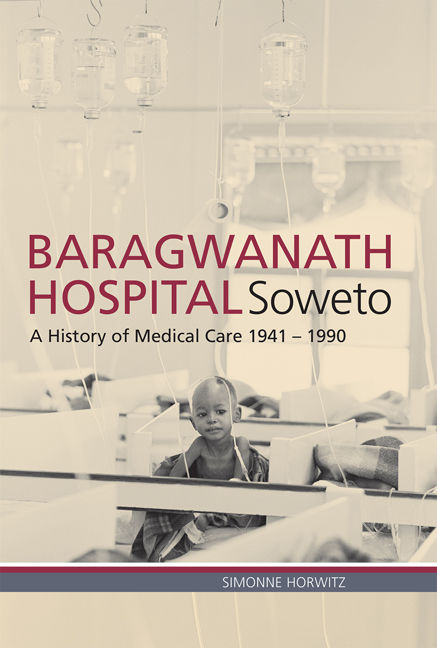Book contents
- Frontmatter
- Contents
- Acknowledgements
- List of Illustrations
- List of Abbreviations
- A note on terminology
- 1 Introduction: A Hospital in Soweto
- 2 From Allied Military Hospital to Urban African Hospital
- 3 Apartheid and Administration: The Hospital, Provincial Administration and the University of the Witwatersrand
- 4 Missionaries, Clinicians, Activists and Bara Boeties: The Doctors of Baragwanath Hospital
- 5 Black Nurses in White: The Nurses of Baragwanath Hospital
- 6 Chronic contradictions: The struggle of Baragwanath in the 1980s
- 7 Baragwanath's Transition and Legacy
- Bibliography
- Index
- Plate Section
3 - Apartheid and Administration: The Hospital, Provincial Administration and the University of the Witwatersrand
Published online by Cambridge University Press: 20 April 2018
- Frontmatter
- Contents
- Acknowledgements
- List of Illustrations
- List of Abbreviations
- A note on terminology
- 1 Introduction: A Hospital in Soweto
- 2 From Allied Military Hospital to Urban African Hospital
- 3 Apartheid and Administration: The Hospital, Provincial Administration and the University of the Witwatersrand
- 4 Missionaries, Clinicians, Activists and Bara Boeties: The Doctors of Baragwanath Hospital
- 5 Black Nurses in White: The Nurses of Baragwanath Hospital
- 6 Chronic contradictions: The struggle of Baragwanath in the 1980s
- 7 Baragwanath's Transition and Legacy
- Bibliography
- Index
- Plate Section
Summary
The apartheid structures and policies had direct and indirect adverse effects on the health status of the majority of black South Africans. They also had a negative effect on the institutions offering care. Yet it is important not to see the negative structural impositions as monolithic. Since Union in 1910, South Africa's health services have been characterised by a multiplicity of health care authorities and systems rather than any single unified system. Baragwanath Hospital found itself answering to two, sometimes competing, masters in the post-1948 period. The hospital functioned under the auspices of the Transvaal Provincial Administration (TPA) but it was also one of the main teaching hospitals of the University of the Witwatersrand. The needs, approaches and politics of each of these groups fundamentally shaped health care for the African population of Soweto and the hospital.
In a 1976 article, J de Beer, secretary for health, stated that: ‘looking at the health service in South Africa today we find a structure which is almost bewildering in its complexity and diversity and certainly much maligned for its fragmentation’. This was nothing new in the mid-1970s. As early as 1928, the annual report of the Department of Public Health had called for better coordination of the different branches of the health infrastructure. Two decades later, evidence given to the National Health Services Commission during the early 1940s often referred to the country's disordered structure of health care services. For example, the evidence of Sir Edward Thornton, director general of medical services, described the health care infrastructure as an ‘unworkable tangle of conflicting interests and jurisdictions’.
Throughout the apartheid period the South African health care system was divided according to race and geographic area. There were significant inequalities between black and white, rural and urban, and primary and tertiary health care. In addition to the public sector, there was a private health care sector catering mostly to the white population.
Similarly, the structure of hospital services – especially those serving the urban African population – suffered from what was, at best, a continual predicament of numerous overlaps and, at worst, chaos. Attempts by the central health authorities to establish coordinating councils failed. The National Department of Health, the Native Affairs Department, the Transvaal Provincial Administration and local councils continued to offer some degree of health service, sometimes complementary and sometimes leading to lengthy debates in Parliament about divided responsibilities.
- Type
- Chapter
- Information
- Baragwanath Hospital, SowetoA history of medical care 1941–1990, pp. 56 - 85Publisher: Wits University PressPrint publication year: 2013



